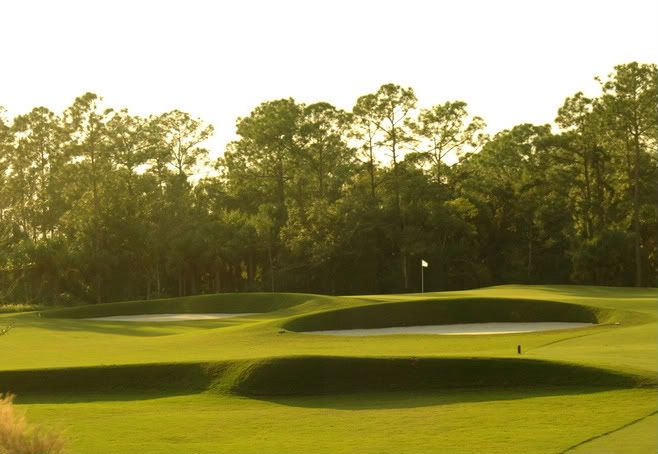I just returned from my trip.
We played two rounds at River Hall based on the pictures and descriptions. I also played six rounds at Fiddlesticks. My camera battery was dead and I forgot my recharger so I did not take pictures.
River Hall is a 2008 housing development club with almost no houses but a full tee sheet. It has little water in play and is quite a contrast from typical Florida golf.
I think it is a course that is worthwhile for anyone to study because I think Love Design did so many things well with the course.
First - there is a lovely angular theme to the shaping on the course. This picture (from the earlier post) shows the bunker style:

An advantage of this bunkering (which I would have never have thought of) is that it provides stern penalties while still allowing my father to enter and exit without undue effort despite a number of physical limitations.
The angular theme is also present on the greens which tend to have more of a rectangular than rounded shape.
Second - the greens and green surrounds are terrific. Without creating over the top contours, there are many spines running through greens, front to back slopes, side to side slopes etx. Furthermore, there is plenty of short grass around the greens making for interesting recovery shots.
Third - greenside bunkering often eats into the greens themselves while usually allowing a ground game approach option.
Fourth - the course is meant to be and during my visit was - maintained very fast and firm.
Fifth - the course does not coddle the player. There are few hidden grass areas right of the fairway or short/right of the green. There are no containment mounds or other devices to keep the ball in play. I noticed few aiming bunkers or other artificial visual clues regarding how to play the course.
Finally - the course is playable for all but also provides an interesting challenge to the better player. This is one course you should play a bit longer than your typical yardage because there are few if any carry hazards and the ball rolls 50 yards or so on a typical tee shot.
Despite all of these positives, the reaction of my group to the course was very mixed. Visually, it is very difficult to make a course look interesting on a flat site with little artificial earth movement. For the most part, each hole seemed similar to holes that had come before.
The holes that really stood out for me had hazards other than bunkers threatening the tee ball. The ninth and 13th used an angled fairway edge to tempt an agressive tee shots to make par fives reachable. The 17th is one of the best short par fours I have played with a severely sloped green guarded by pot bunkers which makes the preferred play off the tee vary with the pin posiition and weather.
Absent those thrills, each tee seemed a lot like others on the course.
I think modern architects have done a terrific job of making courses playable - having learned from the extemely difficult Dye/Nicklaus designs of the 80's. Many architects create terrific green complexes.
I do think architects should focus, if possible, on making courses not only playable, but interesting off the tee. To my mind, this factor distinguishes the terrific courses of recent years, from others. Ideally, the interest comes from hazards that allow for recovery shots.
One way to deal with such situations is a large series of bunkers similar to Southern Dunes in Orlando or Royal Dunes near Phoenix. That approach, however, can be real punitive for the struggling golfer. Another option is artificial mounding. Stoneagle is another course with a unique approach to creating interest with width by using a series of native splotches in the middle of the course with fairways that run together. I'm sure other approaches exist.